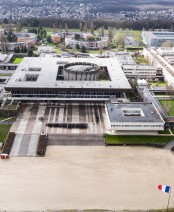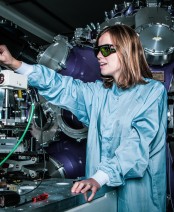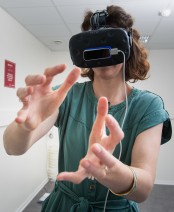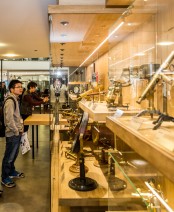50 years of particle physics with IN2P3

 Reynald Pain, director of IN2P3, at Ecole polytechnique, May 19th 2021
Reynald Pain, director of IN2P3, at Ecole polytechnique, May 19th 2021
“Exploring the two infinities” is how Reynald Pain describes the mission of the scientists at IN2P3, the National Institute of Nuclear and Particle Physics of the CNRS. As director of this institute, which has federated French laboratories in this field since 1971, he came with a delegation to celebrate this 50th anniversary with members of the Leprince Ringuet Laboratory (LLR*) and the Center for Microelectronics (OMEGA*), marking the first stage of a tour of France of IN2P3 laboratories. This day was therefore an opportunity to look back at some of the highlights of these 50 years of joint research into the infinitely small and the infinitely large.
From cosmic rays to astroparticle physics
50 years and even a little more, since the LLR was created more than 80 years ago by Louis Leprince Ringuet, shortly after his arrival as a professor at the Ecole Polytechnique in 1936. It was the first research laboratory at the Ecole. Its activity focused on the study of cosmic rays, the high-energy radiation that reaches the Earth from outer space and explains the noise observed in radioactivity experiments. It dawned on scientists that those cosmic rays were made up of a whole bunch of particles. Cosmic rays thus became potential signals for new discoveries, detected thanks to Wilson cloud chambers that show the passage of particles, resulting in a trail of ionized gas particles. The laboratory installed this device in its first off-site facilities, at the L'Argentière laboratory in the Alps. This was followed by the “Laboratoire des Cosmiques”, then the Pic du Midi de Bigorre laboratory, and others. These observations contributed to the discovery of new particles such as the kaon or the hyperons.
Since then, the study of cosmic particles has evolved into 'astroparticle physics': it is no longer just a matter of observing the Universe to discover new microscopic components, but also of extracting information from the detection of its components to learn more about the Universe and its laws. Whether thanks to neutrino experiments with Super-Kamiokande or to gamma-ray astronomy experiments such as the HESS observatory in Namibia, new windows on the cosmos have been opened.
Harvesting particles in accelerators
This was not the only development. The generalisation of particle accelerators in the 1950s made it possible to reproduce, develop and systematise the studies initiated with cosmic rays. In parallel, theoreticians began to build models to account for the wealth of experimental results gathered in a coherent theory, which is now called the Standard Model of particle physics. This is an attempt to 'write the story of the Universe in a universal language', as Yves Sirois, current director of the LLR, points out. These models also predicted new phenomena and new particles, which in turn motivated new experiments in a back-and-forth process that has played, and still plays, a fundamental role in the progress of the discipline. Among the major results are the discovery of the 'neutral currents' in 1973 at CERN thanks to the Gargamelle bubble chamber, the fruit of 20 years of development at LLR; the discovery of the W and Z bosons in 1983, also at CERN; and the discovery of the Higgs boson in 2012, again still at CERN.
From Wilson cloud chamber to electronic sensors
Many of the experiments that led to these results benefited from the long tradition of mechanical, electronic and computer design at LLR, and more recently at OMEGA, a specialist in integrated circuits that equip the ATLAS and CMS experiments at CERN, among others. As Christophe de La Taille, director of OMEGA, reminded us, "without chips, there are no detectors, and without detectors, there are no experiments. "From Wilson's chambers to today's microelectronics-based sensors, huge changes have led to better performances. Bubble chambers such as Gargamelle, for example, have proved insufficient to analyse statistically rare particles. Electronic detectors can now be 'triggered' to record events if they prove interesting. Such a triggering system was designed at LLR for the CMS experiment for CERN's LHC accelerator, which contributed to the discovery of the Higgs boson. Even after this sorting, the quantities of data collected remain colossal, which is why the computing part has taken on a primordial dimension in today's particle physics.
It would take too long to list all the contributions of LLR and OMEGA to the history of particle physics and a more complete chronology can be found here. If the Standard Model seems to be triumphant, this triumph is not complete: matter-antimatter asymmetry, dark matter or the origin of neutrino mass are still enigmas that resist physicists. With experiments such as those on the plasma of quarks and gluons, Super-Kamiokande and the future Hyper-Kamiokande, or the future gamma-ray telescope CTA, the adventure continues, at least until the next anniversary.
*LLR: a joint research unit CNRS, École Polytechnique - Institut Polytechnique de Paris
OMEGA: a joint service unit CNRS, École Polytechnique - Institut Polytechnique de Paris








